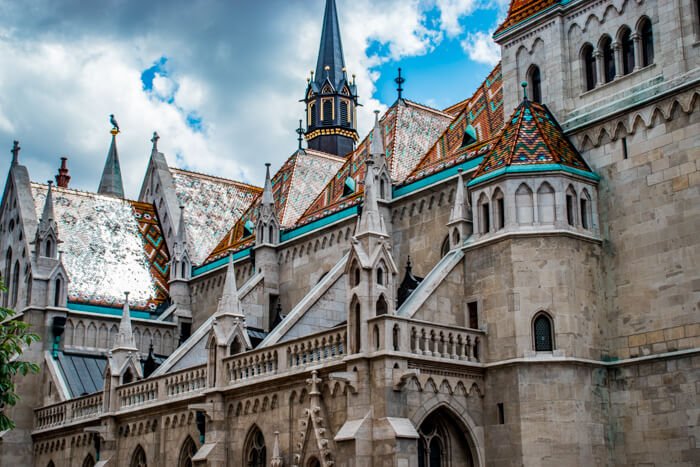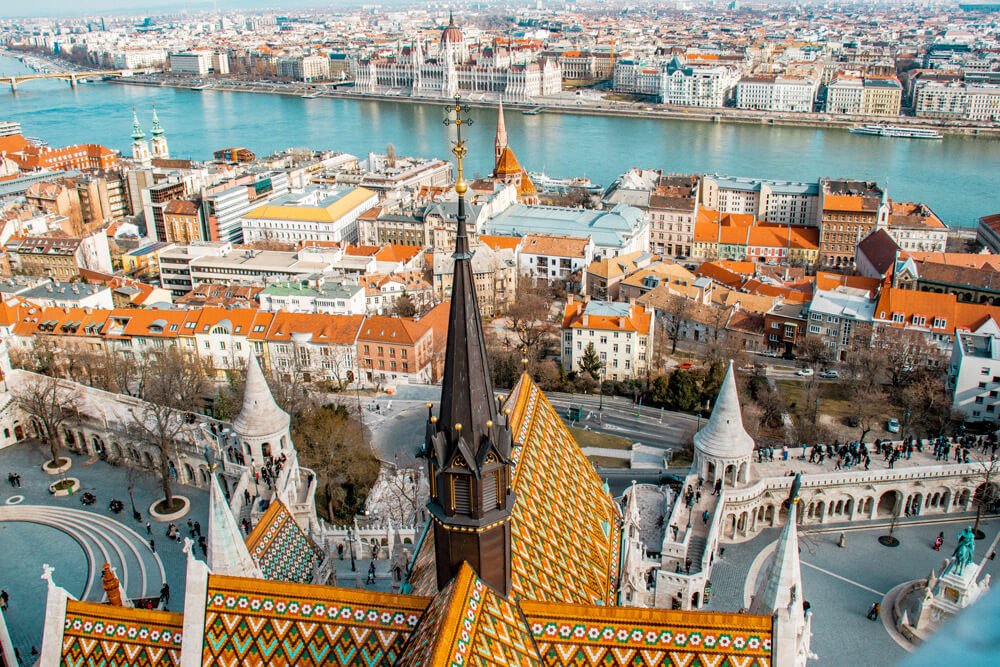Districts and neighborhoods of Budapest are waiting to be discovered. 🙂
City Center

The 5th district is the heart of Budapest.
It is the commercial, administrative center of Budapest and also Hungary.
This is the neighborhood of trendy and expensive shops, restaurants and bars and also the district with some of the most iconic sights in Budapest, such as the Parliament and St. Stephen’s Basilica.
Deák Ferenc Square is the hub of the transportation system since metro lines M1, M2 and M3 all meet here. Here you can have a ride on Budapest Eye ferris wheel and if you set off towards the Danube, you will reach Vörösmarty Square and Váci street, the city’s main pedestrian area.

It is hard to imagine, but what is now the sparkish, full of life Vörösmarty Square, once lay outside the medieval city walls.
Today, the annual Christmas market that takes place on this square is considered to be one of the most beautiful ones in Europe. Gerbeaud, that was the most elite confectioner’s in the 20th century, is still among the most elegant coffeehouses in Budapest.
Váci street is the main shopping street and pedestrian zone in the heart of the district, running parallel to the Danube.
See my post about Downtown Budapest, too!
The Danube Promenade and its neighborhood

The promenade – or as we call it, the Corso – is a pedestrian area on the Danube embankment between the Chain Bridge and Elisabeth Bridge and is one of the most beautiful parts of the city and the best place to admire the Buda side and the World Heritage Danube panorama.
Vigadó Hall
The Vigadó is the most iconic buildings of the embankment. In the 19th century, the concert hall was the venue for balls and festive receptions. Today, it is a cultural center.
In front of the building, there is a life-sized bronze statue of a young girl playing with a dog. The other statue, called Little Princes is sitting on the rails of the promenade. It quickly became one of the most often photographed statues of Budapest.
These two statues make the Vigadó square even more friendly.
The small boulevard and its neighborhood

The edge of the 5th district is at the 1.5-kilometer long Kiskörút (the “small boulevard), that consists of Bajcsy-Zsilinszky út, Károly körút, Múzeum körút and Vámház körút. The boulevard forms a semi-circle between Fővám Square and Deák Ferenc Square.
The small boulevard was developed along the road along the outer side of the medieval city wall.
Central Market Hall – beloved by locals and foreigners alike
This is the biggest market in Budapest and one of the most beautiful one in Europe. It’s world-famous Zsolnay ceramic colored-tiles were made in Pécs. There is an amazingly large space under a huge roof structure.
Kálvin Square
This square was the site of one of the medieval city gates. After a time, the area became so crowded that the gate was demolished, and Pest could expand further.
Today modern glass buildings replace those old, beautiful ones that were destroyed in WW2.
This square is the beginning of Ráday street, one of the most atmospheric areas in Budapest, especially during summer nights.
Palace Quarter

The construction of the Hungarian National Museum increased the value of the surrounding area, and “blue-blooded” families built palaces one after the other. These palaces were built right behind the Museum. Two of the most impressive buildings are Esterházy Palace and Károlyi Palace on Pollack Mihály square.
The Museum is one of the most important ones in Hungary. It also had a major role on the first day of the 1848-49 Revolution.
Astoria Hotel
Astoria, the busy cross-road was named after the Hotel, which was built in the early years of 1910.
The hotel was the headquarters of the German political police (Gestapo) for a short time during the WW2.
Dohány Street Synagogue and the Jewish Quarter

You come to the Jewish Quarter for two reasons: to learn about the city’s Jewish side and it’s crushing history, and to experience the district’s bustling day- and nightlife, the ruin pubs for which Budapest has become famous.
The remains of the old Ghetto are surrounded by trendy coffees, little boutiques, street food spots.
Dohány means “tobacco”, the street was named after a tobacco factory that used to be on this street.
The Synagogue is the largest synagogue in Europe and the second largest in the world, providing seating for 3000 worshipers.
The building is covered with red and white bricks and has ceramic decorations. It’s two onion-shaped domes are 43 meters high.
The Holocaust Memorial in the back garden is directly over the mass graves dug during the 1944-1945 period. This is how the garden that was initially intended as a flower garden became a graveyard. There are about 2200 bodies in the 24 mass graves, half of them still unidentified.
In memory of the Hungarian Jews murdered that time a metal weeping willow statue is erected. Each leaf of the tree bears the name of a victim.
Castle District

The Castle District is the first stop of any sightseeing tour of Budapest. The Royal Castle, Matthias Church and Fishermen’s Bastion are all clustered here, surrounded by quiet cobbled streets with spectacular panorama of the city spread out below.
I can’t imagine that there is a single person who is able to resist the urge to climb up the Castle Hill.
To get to the foot of the Castle Hill, the beginning spot of your climb you will most likely cross the Chain Bridge.
It links Széchenyi István square in Pest and Clark Ádám square in Buda.
The Tunnel – the top of it has a unique panorama to the bridge – was built in 1857.
There are several routes and ways to go up there: you can choose the quickest method, by using the Funicular from Clark Adam Square, or you can climb the stairs (it would take about 15 minutes, max.) or you can take bus 16 from Deák Square (or from Széll Kálmán Square, from the other side of its route) which has two stops in the Castle District.
Once you get up there, you will be able to enjoy the most beautiful panorama of the city while walking around the medieval buildings.
Fisherman's Bastion

A lookout terrace, completely unfit for defensive purposes, looks like a fairytale castle.
Matthias Church

Matthias church received its name because the great Hungarian king Matthias held both of his weddings here.
Some parts of the church date back to the 13th century, while the central part was built around 1400.
Royal Palace

One of the main cultural and turistic center of Budapest. As part of the Castle Hill district, it is a world heritage site.
The building of this palace started in the 1300s.
The state of the palace started to decline when the Turks ruled between 1541 and 1686.
In 1686 it was totally demolished by the army that liberated Buda from the Turkish occupation and was seriously damaged during the WW2.
Today the building houses two large museums (National Gallery and Budapest History Museum) and the National Library.
Gellért Hill

Gellért Hill is a 140 meter-high dolomite rock that descends steeply into the riverbed. It largely contributes to the attractiveness of Budapest. There are about 6000 trees on its slopes, some of which are fig trees planted by the Turks).
It takes some time and effort to walk up on one of it’s walking routes but the unique sight of the city and the numerous scenic spots will make up for your struggle.
Citadel

Located at the top of Gellért Hill, it was built after the Revolution of 1848-1849 with a military purpose. During its history, it has already been a prison, accommodation for homeless, site of an anti-aircraft battery and nowadays, a tourist attraction with the very best views of the whole city.
The 14 meter-high Statue of Liberty commemorates the liberation from the Fascist rule.
The only reason it has not been removed (unlike most of the statues from the Soviet era) is the fact that it has become a symbol of Budapest abroad.
There is more, of course! 🙂
Budapest has so much to offer for both locals and toursits. I try to show you as much as possible on this blog.
Tell me what you are interested in and what you liked the most when you were here.
I really would like to know!
Happy sightseeing! 🙂
Check out my other blog posts, too! 😊


